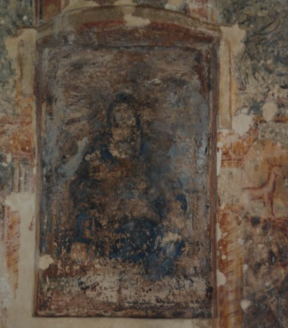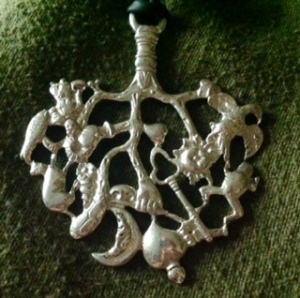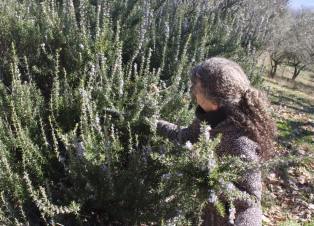The Practice - novenas, incense, charms & amulets, hand mudras, malocchio and healing tools & rituals.
My rural village, with roots going back beyond the Neolithic, sits at the foot of the highest mountain in our area, Mont Cervati, which means Mountain of the Deer. The deer was a totem animal of the Lucani people and the sacred animal of Diana. In much earlier times this mountain was known as her holy ground, her habitat. Her ancient shrine sits atop the mountain in a grotto and people still walk to it in holy pilgrimage in early August as they have for countless centuries.
Diana is now known as Our Lady of the Snow, but the old ones remember She Who Knows. Diana means heavenly, divine and she is our Lady of the Moon, the huntress, guardian of the woodlands and protector during childbirth. She is luminous, shining, and though she has been renamed, she still carries all the old iconographic associations. She is easy to recognize. She is adored as our defender, our guardian spirit and the one from whom our sacred waters, and hence all our nourishment, flows. She is fertile, fruitful and fecund. She is our Buona Dea, our beloved Maria.
As I mentioned in Part 1 of this series, our Southern Italian family-based spiritual traditions are renowned for possessing a great deal of flexibility and fluidity. As a result, the practices found in Benedicaria vary from family to family and from individual to individual. What follows are some traditional practices that are universally practiced in our tradition.
Novenas – A novena is a spiritual prayer ritual conducted for nine consecutive days or nights. We often attend novenas at church but just as often conduct our own novenas at home. Although no two novenas will be the same they do have a common thread…for instance, we usually set up an altar before performing a novena at home. The altar may be a small table or fireplace mantle, which is covered with a white cloth, often decorated with crocheted lace along the edge, according to family tradition; there will usually be one or two white or red candles lit and the altar will hold an icon or a statue of the saint we are invoking. During the novena we recite the rosary, or offer other significant prayers daily during the nine days, to implore help, make a petition or offer thanks for prayers realized.
Incense is an important part of this ritual. Many cultures around the world and throughout time have understood the importance of burning sacred herbs. There are many passages in the bible that tell us that the smoke carries our prayers to God, or Great Spirit.
Myrrh opens the doors to the otherworld; frankincense invites angelic or heavenly protection and is especially uplifting. These two herbs are often burned together in Catholic rituals and used by practitioners of Benedicaria. Many homes have their own unique incense blend.
The blend I use is a combination of sacred herbs and trees that have special meaning to me, and that connect me to my home and my ancestors. This incense is a blend of frankincense and myrrh resins, needles and resins of pine, spruce, and fir, cedar boughs and Baltic amber resin. The incense burned during prayers, blessings and healings is often associated with family history and carries a deep sense of place. Another incense I use is a combination of herbs I gather in my Mediterranean homeland. It combines olive leaves, bay, rosemary, sage, and rose.
A traditional Southern Italian house blessing incense is commonly made with equal parts of camphor, myrtle leaves and nutmeg. When doing a house blessing ritual we burn the incense, allowing the sacred smoke to flow freely, as we sprinkle holy water on all corners of the house, using a bunch of rue or a branch of rosemary, and pray the Our Father, Hail Mary, Glory Be and the Apostles’ Creed.
The psychological aspects of healing and protection through the use of rituals, prayers, dreams, tools, hand mudras, charms, herbs, amulets and talismans represents an important aspect of traditional Southern Italian shamanism/folk medicine.
Malocchio or the Evil Eye is a concern among people of Southern Italia as it is in many other geographical locations around the world. A headache or fever, with no discernible cause or reason, or a string of “bad luck” is often considered to be the result of having been subjected to the evil eye.
Charms and Amulets – There are many types of amulets used to protect from the Evil Eye or to attract good fortune. One common amulet is the cornicello or “little horn”. This is a long, gently twisted horn-shaped amulet usually carved out of red coral or made from gold or silver and hung from a chain around the neck. The horn is usually hollow and therefore ready to be filled with an abundance of blessings that are being poured into one’s life. The top is often decorated with a gold crown to represent success, mastery and wealth. The blessings of this charm are believed to be many: good fortune, protection, virility, strength, success, abundance, and wealth.
When worn as jewelry it is often perceived as a badge of Napolitano cultural identity. It is also hung on rear view mirrors, often seen hanging in shop windows, carried on key rings and printed on t-shirts. The cornicello is generally worn by men, because of its association with virility, but since it confers many other blessings, women sometimes wear it as well.
The origins of this charm are somewhat of a mystery. It may be Roman in origin, stemming from the myth of the cornucopia or magical horn of plenty that was carried by the Roman Goddess Abundantia, whose cornucopia produced never ending supplies of delicious food and gold coins which she poured out generously on those who pleased her.
There is some evidence that the cornicello, or cornetto as it is also known, may come from the Etruscans as their homes would often display a bulls horn above the front door for prosperity. There was an ancient Etruscan settlement in our valley, and their influence is still felt. I often see a set of bull horns placed above the entrance door to rural homes when traveling around the countryside here. Others suggest its origins extend back to Neolithic times and perhaps even farther back than that.
Ideally the cornicello, as with any magical or protective charm, should be received as a gift, which is thought to maximize its luck bringing potential.
In Southern Italian folk healing and herbal lore rue, Ruta graveolans, is considered a most magical and protective herb. It has many medicinal uses and is a key ingredient in any protective amulet. The cimaruta is a classic Neapolitan protective charm that suspends ancient magical and protective symbols from a triple branched sprig of rue. It is a classic talisman for bringing abundance, beauty and grace into one’s life and ensuring the wearer protection from harm. The cimaruta is traditionally made of silver, the metal of Diana, she who was dearly beloved in this part of the world for many thousands of years.
The cimaruta falls under the category of portafortuna, literally door of fortune or “lucky charm”, a term that can be used broadly to describe practically any amulet or talisman. The charm can be worn by women or men, but is generally deemed to be more feminine in nature.
Arcane symbols sprout from the tips of the three rue branches: a waxing crescent moon, a key, a vervain flower, a sacred heart and a fish. The symbolism contained within the cimaruta is a blend of symbols taken from Pagan, Catholic and peasant folk magic, all of which reflect the traditional folk spirituality of Italy perfectly.
The sacred heart, the fish and the triform nature of the branch are all Catholic symbols, representing Jesus, Christian faith and the Trinity. In earlier times the triple branch represented the triple goddess, maiden, mother and crone. The key and the crescent moon are early Pagan symbols representing Hekate and Diana, two Goddesses especially beloved by the Southern Italic tribes, and associated with healing and magic. Rue itself is a powerful protector against malevolent forces in Italian herbal lore as are vervain flowers, which are believed to attract good fortune.
Amber also has an ancient tradition of being worn as a protective shield, or amulet, in Southern Italia. The earliest trade routes from the Baltic Sea carried amber, or ambra, down into the Italic peninsula and across the Mediterranean to Egypt and the rest of the Middle East, where it was also highly prized. The Italians were noted around the globe as the finest amber carvers. In my valley, when archaeologists uncovered graves from 1,500 BC, they found the people had been buried wearing considerable amounts of raw amber. Amber rosaries were and still are, especially prized.
Because amber has a natural magnetic property, it was used to wrap spinning staffs, and thought to attract not only the fibers of wool and flax, but also to bring
good fortune.
Hand gestures – It is thought that ribald gestures distract an offender from the mental effort needed to successfully bestow the Evil Eye. Since one effect of this affliction is to dry up liquids, the drying of the phallus, resulting in male impotence, can be averted by seeking refuge in the moist female genitals.
Those who are not fortified with phallic charms make use of sexual hand gestures to avoid the Evil Eye. Such gestures include the sign of the fig, or la fica, which is a fist with the thumb pressed between the index and middle fingers, representing the phallus within the vagina. Another protective hand gesture is the le corna, where the fist is formed leaving the pinky and index fingers
protruding.
In addition to forming these phallic hand gestures, a statue of a hand in these positions, or a hand covered with magical symbols, are also carried as talismans or placed in the home.
The intentional wielder of the Evil Eye, or the jettatore, is often described as being especially magnetic and possessing a striking facial appearance, with high arching brows and a stark stare that leaps from black or blue eyes. But in truth, anyone can pass the Evil Eye, even unknowingly. Jealousy and envy are considered to be the main culprits and these emotions can cause health disturbances for the object of the envy. To avoid unintentionally giving the evil eye, many people will pass a home keeping their heads down, so as not to look too closely at unique features.
Babies, small children and pregnant women are considered the most vulnerable. When we meet a cute little baby out on the street it is considered best not to make too much of a fuss over it, lest you offend it with the Evil Eye. One way around that is to touch the baby before departing, another is to spit on the ground as you leave, as water prevents the drying up associated with the affliction. These actions prevent the evil eye from being transmitted. Should one fall prey to the Evil Eye, we have healing rituals for removing the condition.
Healing Tools – An assortment of magical tools are employed by Southern Italian Benedicaria practitioners and while these vary greatly depending on family traditions and specific regions, they commonly include antique keys which unite male and female energy, fiber ropes or cords to bind, knives or scissors to cut away illness, and mirrors and various weapons to reflect or scare away malevolent spirits.
My elders taught me the use of three traditional tools to cure the evil eye as well as a ritual procedure for preparing them. The tools we use are a scissor, a knife and an old fashioned key. Each of these tools is individually dropped to the floor nine times in succession to activate them, and this is done each time prior to their use.
After their activation, the tools are held in the dominant hand and placed on the head, or anywhere on the body that is in pain or discomfort. We then proceed to gently tap or stroke the area. Three times on the left, three times at the center and three times on the right, while repeating a secret prayer. This prayer is unique to each practitioner and depends on your family tradition. It is passed along through the family line, usually by the women to a daughter, granddaughter or niece, but can also be shared with a male relative who is interested in healing. Traditionally it is shared only on two nights per year: Christmas Eve at midnight and at midnight before St. Joseph’s Day, March 19th.
While gently tapping the tools on the body, we recite the special prayer a total of three times. We then pray the Hail Mary (Ave Maria) three times, the Our Father (Padre Nostra) three times and the Glory Be (Gloria) also three times. As I have been taught to do, I recite all of these prayers in my ancestral dialect.
Eggs – Another common healing practice is the use of eggs as a form of cleansing, healing and to remove the Evil Eye. The egg is washed, dried, and then covered in holy water, which is usually obtained from a church. The practitioner prays over the egg, saying the Apostles Creed, the Our Father and three Hail Mary prayers. The egg is then rolled over the body of the afflicted in a loosely prescribed pattern, paying especial attention to any area of the body where pain is experienced. It is believed that the egg absorbs any sickness or negative energy. After doing this for approximately fifteen minutes, the egg is broken by throwing it in the toilet and flushing the remains. It can also be taken out of the house and buried in the ground.
The names used for healing practitioners or cunning-folk in Southern Italia vary from region to region, although such names include praticos (wise people), guaritori (healers), fattucchiere (fixers), and donne che aiutano (women who help). At times, they are referred to as streghe (witches), although usually only behind their backs or by those who are either skeptical of their powers or believe they deal in black magic.
Unlike in other parts of Europe, the ways of the Benedetta survived all through the 20th century and into the early 21st century, where they appear to be alive and well.
One important note here is that throughout all of the Burning Times in Medieval Europe, not a single Benedicaria practitioner, cunning-folk or witch, was ever burned at the stake in Southern Italia. These ways were practiced in every home and were neither strange nor unfamiliar; quite the contrary, they were, and still are, commonplace expressions of a unique and ancient culture, a comprehensive synthesis and evolution of spirituality, mysticism and folk healing that took place among an indigenous people across many centuries and is still quietly thriving in the rural mountains of Sud Italia.









